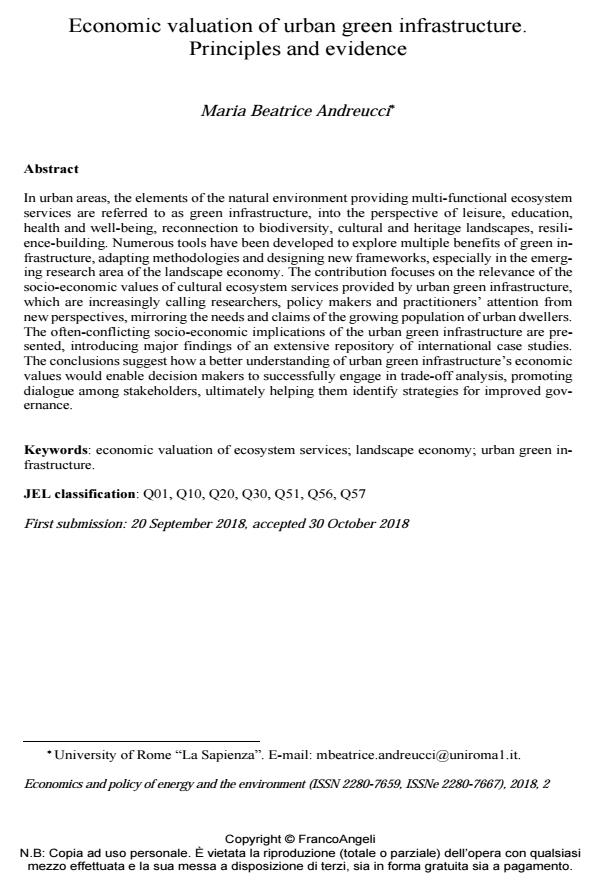Economic valuation of urban green infrastructure. Principles and evidence
Titolo Rivista ECONOMICS AND POLICY OF ENERGY AND THE ENVIRONMENT
Autori/Curatori Maria Beatrice Andreucci
Anno di pubblicazione 2019 Fascicolo 2018/2
Lingua Inglese Numero pagine 22 P. 63-84 Dimensione file 1258 KB
DOI 10.3280/EFE2018-002004
Il DOI è il codice a barre della proprietà intellettuale: per saperne di più
clicca qui
Qui sotto puoi vedere in anteprima la prima pagina di questo articolo.
Se questo articolo ti interessa, lo puoi acquistare (e scaricare in formato pdf) seguendo le facili indicazioni per acquistare il download credit. Acquista Download Credits per scaricare questo Articolo in formato PDF

FrancoAngeli è membro della Publishers International Linking Association, Inc (PILA)associazione indipendente e non profit per facilitare (attraverso i servizi tecnologici implementati da CrossRef.org) l’accesso degli studiosi ai contenuti digitali nelle pubblicazioni professionali e scientifiche
In urban areas, the elements of the natural environment providing multi-functional ecosystem services are referred to as green infrastructure, into the perspective of leisure, education, health and well-being, reconnection to biodiversity, cultural and heritage landscapes, resilience-building. Numerous tools have been developed to explore multiple benefits of green infrastructure, adapting methodologies and designing new frameworks, especially in the emerging research area of the landscape economy. The contribution focuses on the relevance of the socio-economic values of cultural ecosystem services provided by urban green infrastructure, which are increasingly calling researchers, policy makers and practitioners’ attention from new perspectives, mirroring the needs and claims of the growing population of urban dwellers. The often-conflicting socio-economic implications of the urban green infrastructure are presented, introducing major findings of an extensive repository of international case studies. The conclusions suggest how a better understanding of urban green infrastructure’s economic values would enable decision makers to successfully engage in trade-off analysis, promoting dialogue among stakeholders, ultimately helping them identify strategies for improved governance.
Parole chiave:Economic valuation of ecosystem services; landscape economy; urban green infrastructure.
Jel codes:Q01, Q10, Q20, Q30, Q51, Q56, Q57
- Nature-Based Solutions and Circularity in Cities Nataša Atanasova, Joana A.C. Castellar, Rocío Pineda-Martos, Chrysanthy Elisabeth Nika, Evina Katsou, Darja Istenič, Bernhard Pucher, Maria Beatrice Andreucci, Guenter Langergraber, in Circular Economy and Sustainability /2021 pp.319
DOI: 10.1007/s43615-021-00024-1
Maria Beatrice Andreucci, Economic valuation of urban green infrastructure. Principles and evidence in "ECONOMICS AND POLICY OF ENERGY AND THE ENVIRONMENT" 2/2018, pp 63-84, DOI: 10.3280/EFE2018-002004